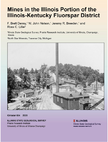Circular 604
Mines in the Illinois Portion of the Illinois-Kentucky Fluorspar District
F. Brett Denny,1 W. John Nelson,1 Jeremy R. Breeden,1 and Ross C. Lillie2
1Illinois State Geological Survey, Prairie Research Institute, University of Illinois, Champaign,Illinois
2North Star Minerals, Traverse City, Michigan
Suggested citation:
Denny, F.B., W.J. Nelson, J.R. Breeden, and R.C. Lillie, 2020, Mines in the Illinois portion of the Illinois-Kentucky Fluorspar District: Illinois State Geological Survey, Circular 604, 73 p. and map.
Abstract
This report compiles into a cohesive document details of the individual mines within the Illinois portion of the Illinois-Kentucky Fluorspar District (IKFD). This document also contains brief sections concerning the mining methods, geology, historical production figures, and theories of the origin of the ore deposits. In 2012, the Kentucky Geological Survey produced a map of the IKFD that covers only the Kentucky portion. The mine location map that accompanies this document was designed to augment the Kentucky fluorspar mine map. During research activities for this project, we gained access to confidential unpublished files from several mining companies. Maps, exploration reports, drill logs, and production figures were scanned and are available upon request at the Prairie Research Institute. Although the last mines in Illinois ceased operations in 1995, there is potential for future mining activities in deeper, relatively unexplored strata. The authors hope this report and the scanned documents will be helpful for future exploration activities and to other interested parties.
Introduction
The Illinois-Kentucky Fluorspar District (IKFD) was, for most of the 20th century, the primary source of fluorspar for the United States. The strategic importance of fluorspar was heightened during World War II because of the use of fluorspar in steel manufacturing. Production of fluorspar ore in this region peaked shortly after World War II and was sustained until the 1970s, when competition from foreign suppliers began to erode the dominance of this mineral district. The early mines were originally operated by dozens of local entrepreneurs producing small tonnages of fluorspar, but in the 1930s, corporate ventures such as Ozark-Mahoning and the Aluminum Ore Company (a precursor of ALCOA) entered the picture. The larger companies erected modern processing mills that allowed a lower grade ore to be enriched into a commercial product. Historical photographs of mines and mining activities in this district provide a nice pictorial archive of these mines and are compiled in the book Fluorspar Mining: Photos from Illinois and Kentucky, 1905–1995(Russell 2019).
“Fluorspar” is an industrial synonym for the mineral fluorite. The chemical formula for the mineral is calcium difluoride (CaF2). The fluorspar ore found in the IKFD is usually not 100% CaF2 and contains minor impurities, mainly calcite and quartz. The ore may also contain galena, barite, and sphalerite, which can be separated and sold. For much of the 19th century, mining concentrated on galena, and fluorite was considered a waste product (Goldstein and Williams 2008). By the late 1800s, fluorspar was being utilized as a fluxing agent in the smelting of steel, which made fluorspar a valuable commodity. From 1914 to 1915, the ores of the IKFD accounted for more than 99% of fluorspar production in the United States (Weller et al. 1920).. In about 1953 to 1954, the major use of fluorspar shifted from predominantly steel manufacturing to the manufacturing of hydrofluoric acid for the chemical and aluminum industries (Voskuil and Bush 1955). The primary uses of fluorspar today include the production of hydrofluoric acid and various other chemicals, steel manufacturing, aluminum smelting, hydrofluorocarbon, and fluoropolymer production (McRae 2016).
Continue Reading
Circular 604 | Production History | Geology of the Illinois-Kentucky Fluorspar District | Mining Methods | Mineral Subdistricts and Individual Mines | Conclusions and Acknowledgments
References
|
|
|
|
|


